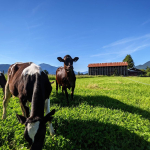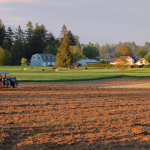Ask an Expert: Wealth & Retirement Strategy

Planning In Your Thirties and Beyond
Karen Fenske
Developing a well-balanced financial strategy at each stage of life promotes peace of mind. The wealth and retirement planning strategies outlined below are relevant for young farmers, whether you will own property or not. The need for supplemental income component has historically been a reality for many producers, and most likely will continue.
Planning for the future means looking at what you can do now, as well as what you’ll need later, and designing a “bridge” to get you there. As a Financial Coach, I help you work through a planning process to determine what your needs are now, and in the future, and what you’ll have to put in place to meet those needs.
Setting Your Goals
- First, it’s important to define your goals and priorities. Some areas to explore include:
- Manage your cash flow: Track your income & spending. With all the apps available today, this can be easy.
- Build an emergency fund: Know your expenses and “pay yourself first” by automatically putting money into a reserve account that is at arm’s length.
- Protect your family in case of deaths, disability or critical illness: Insurance is an important risk management component for all family sizes. If one of the adults becomes ill or passes away the family left behind can be cared for financially. In your thirties insurance is fairly cheap and quick to obtain.
- Make space for travel, vacations, and leisure activities, (travel to see family, skiing, dirt biking, camping, etc.): What, when & how much? If you plan ahead, the tendency to splurge or put it on credit will be reduced. You can manage your expectations and maintain control.
- Plan for major purchases, such as vehicles, real estate, livestock, etc: What, when & how much? If you plan then you may not splurge and end up in “bad debt”. You can manage your expectations and maintain control.
- Own your own business: Create a business plan, even a vague one that will highlight income potential and costs.
- Learn to invest wisely, staying ahead of the cost of living & reducing taxes: You may say I can’t save anything to invest for the future and I always say, “We can find $50 or $100 a month!” to get the habit started. Typically, the saving/investment tool depends on your tax bracket. It often makes sense to save in a TFSA investment where you gain a return on your deposit and the compound earnings grow for your retirement. If you are above a certain income level an RRSP helps reduce your current income tax payable. RRSPs are a “tax deferral program” so a tax refund may be triggered now, but when you go to pull it out later (in retirement) you will pay the tax. Reinvest the refund into the RRSP or TFSA.
- Plan for your child’s education: If you have children, put aside money into an RESP. You can contribute as little as $25 a month, and the government will also contribute. The investment earns a return and the whole account grows. The funds may be used for trade, college, and university programs. Grandparents can arrange these too. It may not be a lot, but it will help!
- Stay employable: Continuous learning is part of our culture. We never know when our source of income might change. What skills, courses, and experience will you need?
- Ensure your money lasts through retirement: Learn about your Retirement Equation: Old Age Security, Canada Pension Plan, etc. Add to your retirement equation via “Supplemental Income.”
- Preserve your estate: Ensure your loved ones are your beneficiaries in your will, etc.
- Give to charity: This can satisfy personal values and reduce taxes.
- Own your farm: What, when & how much? All of the other pieces can be implemented whether this goal is realized or not. This is a whole other topic which will include succession and estate planning.
Review Reality and Add Peace of Mind
Once you’ve got a sense of your dream, it’s important to review reality—and add peace of mind. To do this, first you need to paint a picture. Review your current situation by pulling together all your financial documents, including bank accounts, insurance, debt, credit card statements, etc. I typically enter all the data into my financial planning software to create a whole financial picture and keep track. Explore your expenses: What does it cost to live? What do you need? Can things be changed, cut out, modified, delayed, achieved in steps, etc.? Also, explore your income sources.
As a farmer, this will likely include both your farm revenue and any supplemental income sources. What can you do off-farm to receive a paycheck, such as working part-time as a teacher, welder, nurse, instructor, snow removal tech, clerk, etc. This kind of employment will also add to your Canada Pension Plan (CPP) amount which pays out as early as 60 years old, and adds to your Employment Insurance (EI), which will help with medical leaves and periods of unemployment. You can arrange to contribute to EI even if you are self-employed. If you find employment with a hospital, school district, regional district, etc. You may even be entitled to a pension at some point. All these pieces together with your Old Age Security at 65 and your retirement equation may surprise you. I typically provide the potential future value which helps clarify need and strategies.
If working off-farm is not an option, or costs more than you would earn, consider an on-farm opportunity such as doing bookkeeping for others, machine repair, website development, snow removal, breeding dogs or cats, etc. Ensure you are contributing to CPP for your retirement, and maybe EI, too.
Something to keep in mind with these “supplemental income” options is work-life balance. Look at your whole equation. Every situation is going to be a little bit different. Your resources, skills, capacity, energy level, likes, needs, etc. will impact what is optimum for you. It’s easy to stretch yourselves too thin and end up disheartened, cranky, depressed, or divorced because there hasn’t been enough time or energy. Money is important but so is enjoying life and living it together.
It’s also important to look at your on-farm income. Whether you’re running your own farm or working for another farmer will change the picture. If you’re self-employed, your cost of production should account for your time so that you’re paying yourself a wage that supports your lifestyle—and future goals. As an employee, your job title and description determine your role, and can be helpful in figuring out how you’ll be compensated. For example, an Operations Manager and farm hand will have different levels of responsibility, and thus compensation. If you’re working on a farm as part of a succession planning process, whether on the family farm or not, discussions around compensation can get trickier. Using a third-party coach to facilitate this discussion as part of the succession planning process may be helpful. As an employee the owner will contribute to EI & CPP—this isn’t as complicated as it sounds! QuickBooks is cheap and you can get it all done.
Understanding your income and expenses helps you know how much you will have to live on. You can then budget spending and short term and retirement savings, and create a “doable” budget just for you. Build a “zero-based” budget including income from all sources and living expenses, such as gas, groceries, clothing, insurance, and short term and retirement savings. Every situation is different so meet your family’s needs and don’t compare to others.
Evaluate, Adjust, and Enjoy!
Financial planning is an ever-evolving process, and doesn’t stop once you’ve got your budget in place. Evaluate on a monthly basis, at minimum, where your money is going. There are apps and bank programs to help keep track. You can adjust the budget for surprise costs, add extra to your savings, or pay off debt faster.
It is good practice, once or twice a year, to ask your family, “What great things did we do,” “What was new, different or better?”, “Did we have enough or too little?”, “Do we need to make changes & how?”, “What do we want to do this year and next?”
Cast a big picture of realistic potential income and how your family is going to spend it: who needs a bike, clothes, tools, what kind of trips, etc. You can start an envelope for the goal or assign a piece of your savings accounts or TFSA to that goal.
Each of you has your own unique money story that impacts how you save and spend. Choose transparency instead of denial, courage to ask for your needs to be met, respect that you are in this together, and above all, use sound financial planning to help you enjoy life!
Sustainable agriculture is Karen Fenske’s vocation. After providing strategic planning in BC agriculture, and working for COABC & BC4H, Karen transitioned into the financial planning industry to assist with succession and estate planning. Through her business, Fenske Financial Coaching, she facilitates the transition process and provides relevant, useful advice on a fee-for-service basis.
Featured image: Credit Michaela Parks.




